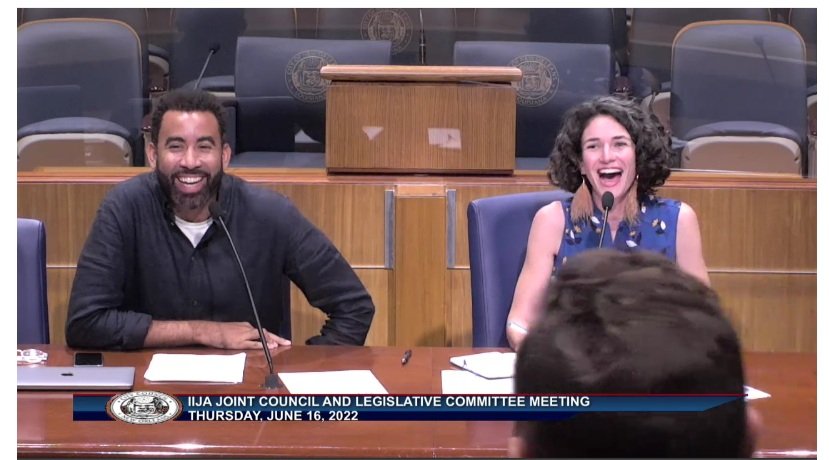Infrastructure money is coming. How do City Agencies want to spend it?
Last month, New Orleans City Council kicked off their IIJA Joint City Council Legislative Committee - a committee to bring together City leaders, State legislators, residents, and other stakeholders to discuss and develop the City’s plan for billions of dollars in Federal infrastructure grants through the Infrastructure Investment and Jobs Act (IIJA). IIJA includes over 350 federal programs. Some of these funds are guaranteed for New Orleans, but many we’ll have to apply for, so a coordinated plan will be critical for the City’s success.
The committee includes all 7 City Council Members, our LA state legislators, and a representative from Congressman Troy Carter's office. The committee will meet monthly through the end of 2022.
At the first meeting on June 16, 2022, the Committee heard presentations from key City agencies about their approach and priorities for the IIJA funding.
What's IIJA?
A policy that Congress passed last year that will provide $550 billion in new federal spending on U.S. infrastructure over the next five years. Money will be spent on transportation, high-speed internet, clean water, the energy grid, climate resilience, and many other areas. Learn more here.
Why IIJA is important for New Orleans
IIJA Committee Meeting Recap
At the June 16th meeting, we heard City Agencies' prioirties to bring in as much Infrastructure Investment & Jobs Act (IIJA) investment as possible to build resilient infrastructure in New Orleans. Committee members agreed that our most left-out residents need to see and feel the impact of these projects in every neighborhood. Click here to see presentations from the City of New Orleans CAO's office, Regional Transit Authority, Sewerage & Water Board, Port of New Orleans, and Committee for a Better New Orleans, and read on for highlights.
City of New Orleans Chief Administrative Office
Approach: The Administration has convened a task force that includes members of the Departments of Health, Homeland Security & Emergency Preparedness, Resilience, Community Assets and Development, and Utilities.
Priorities: Secure as many grants as possible, by matching existing City plans and priorities (including from the Capital Improvement Plan) with Federal grant program requirements. Most of the available funding is for transportation infrastructure, so that’s an area of particular focus.
Priority Grants include:
Downtown Transit Center & Transit Connections (RAISE), applied in partnership with the RTA - SUBMITTED
Community Microgrids for Storm Resilience (RACER) - SUBMITTED
Safe Streets and Roads for All - to prevent transportation-related death and serious injury on streets.
Federal Lands Access Program - to improve access to Bayou Sauvage in New Orleans East.
Bridge Formula Program (BFP)
Bridge Investment Program (BIP)
Clean School Bus Program (with NOLAPS)
PROTECT - for resiliency of transportation infrastructure
Transmission Facilitation Program (2023, with Entergy)
Brownfields Program
Sewerage and Water Board New Orleans
S&WB emphasized that as a utility, they’re eligible to apply for more water quality programs than water management programs. The S&WB has created an internal task force that plans to apply for as many programs as possible. They identified over 20 priority uses, including:
Lead Line Replacement (EPA/LDH): $42M/yr, 5 years. Will require LSL inventory (not yet complete)
Drinking Water State Revolving Fund (EPA/LDH): ~$3M project cap
Clean Water State Revolving Fund (EPA/LADEQ)
Cyber Resiliency (BRIC/FEMA)
Port of New Orleans
Port of New Orleans emphasized plans to grow their capacity and repair and restore crucial connections, including:
Bridges; especially St. Claude Bridge and Almonaster Bridge
Louisiana International Terminal (which will accept megaships before the CCC)
Rail Yard Expansions to increase capacity and reduce impact on traffic near rail lines.
Large-scale improvements to wharves and waterways
Port security improvements
Regional Transit Authority
RTA emphasized the priorities in the 2018 Strategic Mobility Plan, including:
Downtown Transit Center @ Canal & Elk
Bus rapid transit to improve connections from the West Bank and New Orleans East to downtown
Piloting Transit Oriented Communities
Modernizing bus fleet to include more fuel efficient and more sustainable vehicles.
ADA compliance & bus shelters
Committee for A Better New Orleans
We’re thrilled to say we’ve got your back in the room where it happens. We’re working hand-in-hand with the Council IIJA Joint Legislative Committee and the City of New Orleans to educate residents and stakeholders, gather priorities, and strengthen New Orleans’ IIJA proposals to ensure our City is prepared to make the most of these historic opportunities.
Our team presenting to City Council’s IIJA Committee on June 16, 2022
Get involved!
Committee for a Better New Orleans is helping you understand, navigate, and influence these decisions and make your voice heard.
Learn more & get involved at our next Stakeholder meeting on Wednesday, July 13th, from 6-7:30pm.







